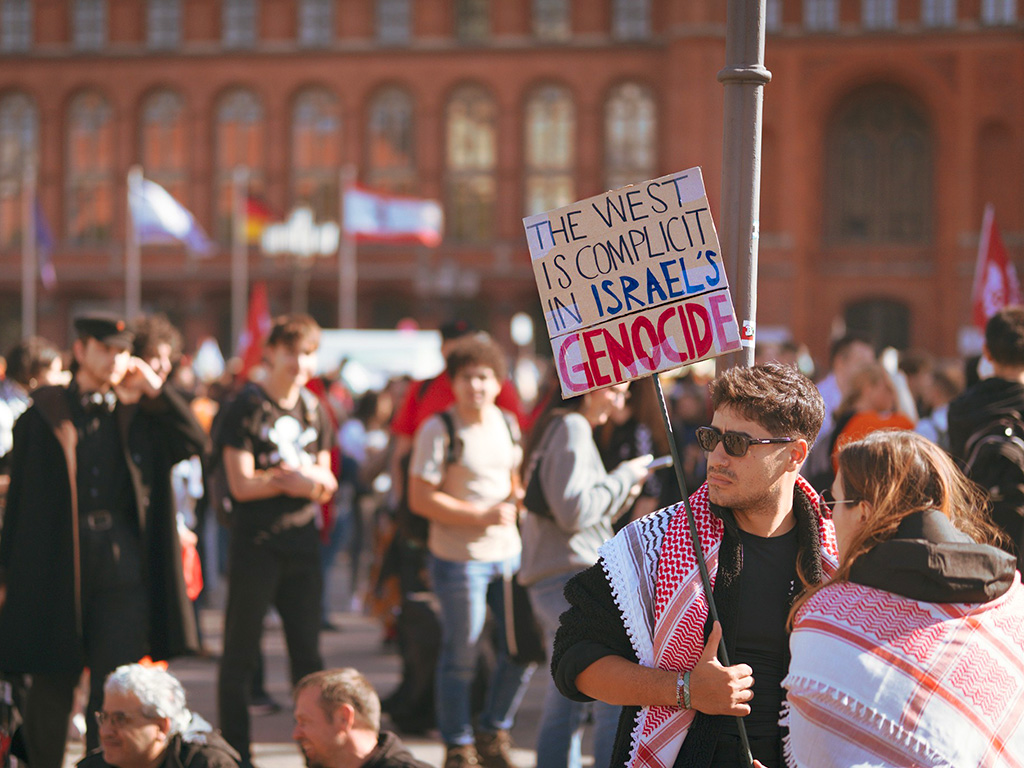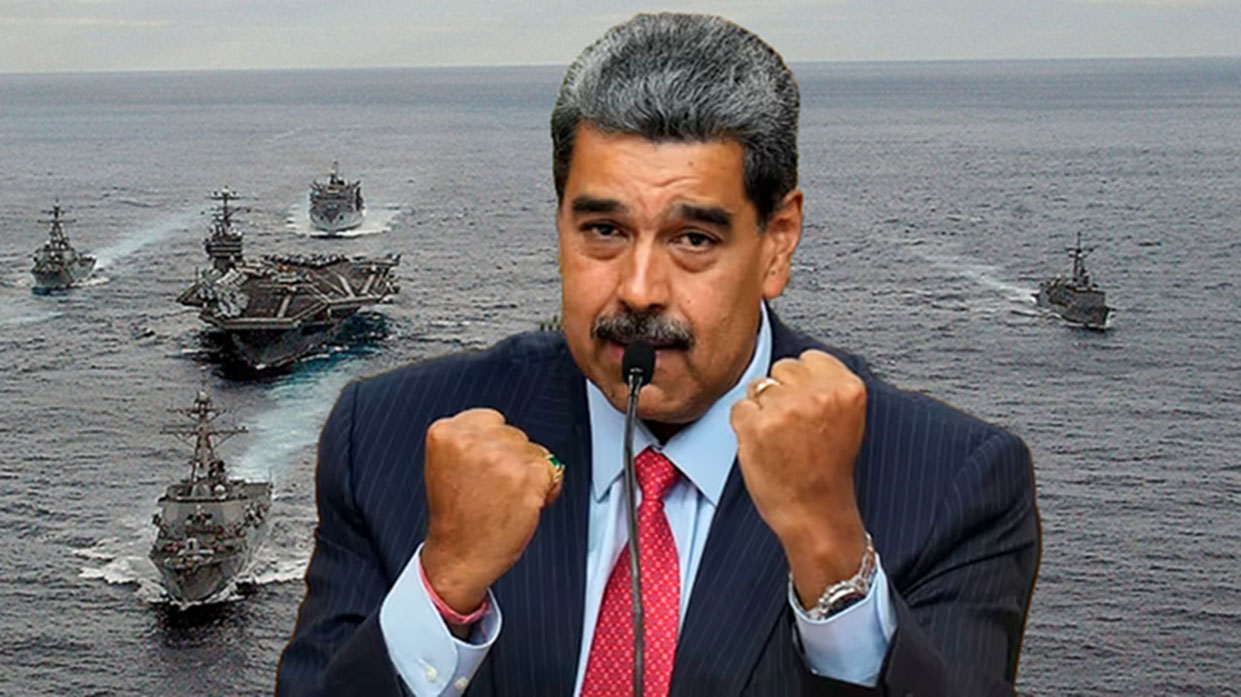Carlos Taylhardat | 3 Narratives News | September 27, 2025
I haven’t written much on Gaza lately, not from apathy, but from sadness. Today the streets wrote their own headline. From Berlin and Rome to New York and Sydney, huge crowds demanded a ceasefire and basic dignity for Gazans. In USA, leaders from both sides the right and left are in agreement regarding the situation in Gaza from Sen. Bernie Sanders pressed to Piers Morgan has publicly challenged Israeli officials over civilian deaths.
What’s happening

- Germany (Berlin): Police estimate ~50,000 marched; calls to end arms exports; 1,800 police deployed. AP/Euronews
- United States (New York City): Thousands rallied around the UN; inside the hall, scores of diplomats walked out during PM Benjamin Netanyahu’s speech. Reuters/The Guardian
- Italy & Europe: Large coordinated marches across major cities. European live coverage
- Australia (Sydney): One of the year’s largest sustained turnouts. Reuters prior reporting
- Australia — scale and recognition
- On August 24, 2025, more than 40 pro-Palestinian rallies erupted across Australia after the federal government recognized a Palestinian state. Organizers claimed ~350,000 people nationwide, with major turnouts in Sydney, Melbourne, and Brisbane. Reuters
- The Sydney Harbour Bridge protest (Aug 3) remains iconic: protesters marched across the bridge in solidarity with Gaza. Estimates vary, but it’s among the largest mobilizations in Australia in recent years. Wikipedia
- Italy — strikes + port blockades
- Italy mobilized a nationwide general strike in September 2025 in solidarity with Gaza. Over 75 municipalities joined; factories, schools, and ports were disrupted. Wikipedia+1
- In Milan, clashes broke out near the Centrale train station, with protesters throwing projectiles and police responding with tear gas. The Guardian
- Dockworkers in cities like Genoa and Livorno blocked arms shipments bound for Israel. Le Monde.fr+1
- Gaza itself — protests against Hamas
- Within Gaza, protests began in March 2025 against Hamas rule. Citizens demanded an end to the war, food, and political change. In Beit Lahia, thousands protested with chants like “Hamas out” and “We want to live.” Wikipedia
- In the Jabalia refugee camp, demonstrators burned tires and shouted for an end to the war, rejecting both Hamas and the conflict. Wikipedia
- Netherlands / Europe symbolism
- In The Hague, the “Red Line Demonstrations” involved protesters wearing red to form symbolic lines around the Peace Palace (ICJ), demanding that the Dutch government and EU cut ties with Israel and pressure a ceasefire. Wikipedia
The Global Ceasefire Wave
To protesters, the case is moral and simple: enough.
In Berlin, an estimated 50,000 people marched through the Brandenburg Gate, waving banners demanding an end to bombardment and a halt to German arms exports to Israel. Police deployed 1,800 officers but reported no major violence.
In New York, thousands surrounded the UN complex during Prime Minister Netanyahu’s speech, chanting “Ceasefire now” as scores of diplomats staged a walkout inside. The atmosphere was part grief, part defiance, handmade posters bore the names of Gazan children killed, while speakers linked U.S. weapons sales to the devastation.
In Italy, protests spilled beyond piazzas into factories and ports. Dockworkers in Genoa and Livorno blocked ships suspected of carrying arms, while Milan saw street clashes with police. The general strike brought schools and transit to a halt, transforming solidarity into economic disruption.
In Sydney, tens of thousands crossed the Harbour Bridge, some carrying giant papier-mâché keys symbols of Palestinian homes lost in 1948. In Melbourne and Brisbane, rallies followed after Australia formally recognized Palestine, underscoring how public pressure had already shifted policy.
In Buenos Aires, mothers of the disappeared joined Palestinian-Argentine families to call the war a
“new dictatorship of hunger and bombs.”
In Nairobi, student unions marched alongside clergy, demanding Africa not remain silent. In Kuala Lumpur, protests took over central squares, tying Gaza’s famine to wider concerns about global food insecurity.
Even in The Hague, home to the International Court of Justice, protesters dressed in red formed “human lines” around the Peace Palace, demanding Europe enforce the ICJ’s rulings on humanitarian law.
Everywhere, the chant boiled down to a single word in many languages — kifayah. basta. genug. enough.
Polls show the protests reflect a real shift: Gallup now finds only 32% of Americans approve of Israel’s Gaza campaign, while Reuters/Ipsos surveys show 58% favor recognizing a Palestinian state and 65% want Washington to act against starvation in Gaza.
Israel’s Case
From the Israeli perspective, the war is framed as a national imperative, a fight for survival—not choice. That view is echoed not only in political rhetoric but in how the public and officials speak of Hamas, hostages, and existential threat.
Netanyahu & Official Rhetoric
- In his UN address, Prime Minister Benjamin Netanyahu declared: “Israel must finish the job in Gaza as fast as possible.”
“Lay down your arms. Free all [the] hostages now … If you do, you will live. If you don’t, Israel will hunt you down.” The Guardian+3The Guardian+3Reuters+3
He also lambasted Western nations for recognizing a Palestinian state, calling it “sheer madness.” The Guardian+3Reuters+3The Guardian+3 - Netanyahu reaffirmed Israel’s intent to continue military operations until Hamas is dismantled and all hostages freed: “That is why Israel must finish the job.” Reuters+2The Guardian+2
- In a press conference, talking about lessons from this war, Netanyahu said Israel needs an “independent weapons industry” that can “withstand international constraints.” Reuters
- In remarks by a senior minister, Israel Katz warned Gaza residents: “Return the hostages and eliminate Hamas … The alternative is complete destruction and devastation.” Wikipedia
These statements make clear the predominant Israeli narrative: dismantle Hamas, secure hostages, and maintain military leverage, even amid global outcry.
Officials with Harder Lines
Some Israeli politicians with more extreme rhetoric also matter, because they reflect voices in power or in public conversation:
- Bezalel Smotrich, an Israeli lawmaker, has stated publicly that “Gaza will be totally destroyed” and that Palestinians will eventually be pressurized to relocate. Wikipedia
- Smotrich has also said the State of Israel will
“no longer be able to put up with the existence of an independent entity in Gaza.”
These voices underscore how, in some factions, the rhetoric pushes beyond military necessity into maximalist language.
Ordinary Israelis & Soldiers (Limited Public Quotes)
Finding verified, unfiltered remarks from average Israeli citizens in the middle of an ongoing war is challenging for operational security, censorship, and media constraints. But there are some reported testimonies from border towns and affected communities:
- In Sderot, a town repeatedly shelled by rockets, residents have described life there as living “in hell” because of repeated strikes. Deep Blue Repositories
- From a past travelogue of Israelis in conflict-affected zones: “We have spent seven years in hell.” — an Israeli reported in Sderot. Deep Blue Repositories
Though not fresh quotes from 2025, they reflect the lived anxiety in Israeli border communities under rocket threat.
Narrative 3: The Silent Story
Grief saturation is everywhere—hostage families pleading; Gazan families burying loved ones and fleeing hunger. U.S. support has eroded even as Washington shields Israel at the UN. Allies diverge: some recognize Palestine; others hold off. The longer the war runs, the harder the politics get for everyone.
Key Numbers
- Berlin: ~50,000 protesters; 1,800 police.
- UNGA: “Scores” walked out on Netanyahu; some outlets reported 100+ from 50+ countries.
- U.S. opinion: 32% approve Israel’s Gaza campaign (Gallup); 58% support recognition of Palestine; 65% want stronger U.S. action against starvation (Reuters/Ipsos).
- Congress: Senate rejected Sanders’ bids to halt weapons sales, but margins tightened vs. earlier attempts.
Related at 3N
The UN at 80: Speeches, Standoffs, and the Memory We’re in Danger of Losing • Can the Rift Be Repaired? Left vs Right


